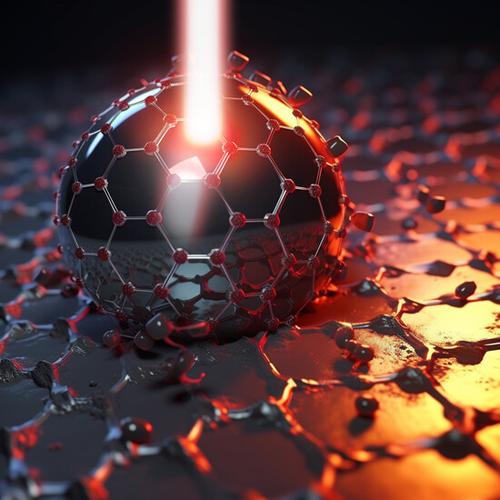当前位置:
X-MOL 学术
›
Carbon Energy
›
论文详情
Our official English website, www.x-mol.net, welcomes your feedback! (Note: you will need to create a separate account there.)
Pioneering the direct large-scale laser printing of flexible “graphenic silicon” self-standing thin films as ultrahigh-performance lithium-ion battery anodes
Carbon Energy ( IF 20.5 ) Pub Date : 2024-02-21 , DOI: 10.1002/cey2.507 Avinash Kothuru 1 , Adam Cohen 2 , Gil Daffan 2 , Yonatan Juhl 2 , Fernando Patolsky 1, 2
Carbon Energy ( IF 20.5 ) Pub Date : 2024-02-21 , DOI: 10.1002/cey2.507 Avinash Kothuru 1 , Adam Cohen 2 , Gil Daffan 2 , Yonatan Juhl 2 , Fernando Patolsky 1, 2
Affiliation

|
Recent technological advancements, such as portable electronics and electric vehicles, have created a pressing need for more efficient energy storage solutions. Lithium-ion batteries (LIBs) have been the preferred choice for these applications, with graphite being the standard anode material due to its stability. However, graphite falls short of meeting the growing demand for higher energy density, possessing a theoretical capacity that lags behind. To address this, researchers are actively seeking alternative materials to replace graphite in commercial batteries. One promising avenue involves lithium-alloying materials like silicon and phosphorus, which offer high theoretical capacities. Carbon–silicon composites have emerged as a viable option, showing improved capacity and performance over traditional graphite or pure silicon anodes. Yet, the existing methods for synthesizing these composites remain complex, energy-intensive, and costly, preventing widespread adoption. A groundbreaking approach is presented here: the use of a laser writing strategy to rapidly transform common organic carbon precursors and silicon blends into efficient “graphenic silicon” composite thin films. These films exhibit exceptional structural and energy storage properties. The resulting three-dimensional porous composite anodes showcase impressive attributes, including ultrahigh silicon content, remarkable cyclic stability (over 4500 cycles with ∼40% retention), rapid charging rates (up to 10 A g−1), substantial areal capacity (>5.1 mAh cm−2), and excellent gravimetric capacity (>2400 mAh g−1 at 0.2 A g−1). This strategy marks a significant step toward the scalable production of high-performance LIB materials. Leveraging widely available, cost-effective precursors, the laser-printed “graphenic silicon” composites demonstrate unparalleled performance, potentially streamlining anode production while maintaining exceptional capabilities. This innovation not only paves the way for advanced LIBs but also sets a precedent for transforming various materials into high-performing electrodes, promising reduced complexity and cost in battery production.
中文翻译:

首创直接大规模激光打印柔性“石墨硅”自支撑薄膜作为超高性能锂离子电池负极
最近的技术进步,例如便携式电子产品和电动汽车,迫切需要更高效的能源存储解决方案。锂离子电池(LIB)一直是这些应用的首选,石墨因其稳定性而成为标准阳极材料。然而,石墨无法满足日益增长的更高能量密度的需求,其理论容量落后。为了解决这个问题,研究人员正在积极寻找替代材料来替代商用电池中的石墨。一种有前途的途径涉及硅和磷等锂合金材料,它们具有较高的理论容量。碳硅复合材料已成为一种可行的选择,与传统石墨或纯硅阳极相比,其容量和性能有所提高。然而,现有的合成这些复合材料的方法仍然复杂、能源密集且成本高昂,阻碍了广泛采用。这里提出了一种突破性的方法:使用激光写入策略将常见的有机碳前体和硅混合物快速转化为高效的“石墨硅”复合薄膜。这些薄膜表现出卓越的结构和能量存储特性。由此产生的三维多孔复合阳极展现出令人印象深刻的属性,包括超高硅含量、显着的循环稳定性(超过4500次循环,保留率约40%)、快速充电速率(高达10 A g -1)、巨大的面积容量(> 5.1 mAh cm -2)和出色的重量容量(0.2 A g -1时>2400 mAh g -1)。这一战略标志着高性能锂离子电池材料的规模化生产迈出了重要一步。利用广泛可用的、具有成本效益的前体,激光打印的“石墨硅”复合材料表现出无与伦比的性能,有可能简化阳极生产,同时保持卓越的能力。这项创新不仅为先进的锂离子电池铺平了道路,而且还开创了将各种材料转变为高性能电极的先例,有望降低电池生产的复杂性和成本。
更新日期:2024-02-25
中文翻译:

首创直接大规模激光打印柔性“石墨硅”自支撑薄膜作为超高性能锂离子电池负极
最近的技术进步,例如便携式电子产品和电动汽车,迫切需要更高效的能源存储解决方案。锂离子电池(LIB)一直是这些应用的首选,石墨因其稳定性而成为标准阳极材料。然而,石墨无法满足日益增长的更高能量密度的需求,其理论容量落后。为了解决这个问题,研究人员正在积极寻找替代材料来替代商用电池中的石墨。一种有前途的途径涉及硅和磷等锂合金材料,它们具有较高的理论容量。碳硅复合材料已成为一种可行的选择,与传统石墨或纯硅阳极相比,其容量和性能有所提高。然而,现有的合成这些复合材料的方法仍然复杂、能源密集且成本高昂,阻碍了广泛采用。这里提出了一种突破性的方法:使用激光写入策略将常见的有机碳前体和硅混合物快速转化为高效的“石墨硅”复合薄膜。这些薄膜表现出卓越的结构和能量存储特性。由此产生的三维多孔复合阳极展现出令人印象深刻的属性,包括超高硅含量、显着的循环稳定性(超过4500次循环,保留率约40%)、快速充电速率(高达10 A g -1)、巨大的面积容量(> 5.1 mAh cm -2)和出色的重量容量(0.2 A g -1时>2400 mAh g -1)。这一战略标志着高性能锂离子电池材料的规模化生产迈出了重要一步。利用广泛可用的、具有成本效益的前体,激光打印的“石墨硅”复合材料表现出无与伦比的性能,有可能简化阳极生产,同时保持卓越的能力。这项创新不仅为先进的锂离子电池铺平了道路,而且还开创了将各种材料转变为高性能电极的先例,有望降低电池生产的复杂性和成本。



























 京公网安备 11010802027423号
京公网安备 11010802027423号